Finance Assignment: Keynesian Model, Investment, Taylor Rule Analysis
VerifiedAdded on 2023/05/31
|8
|1543
|181
Homework Assignment
AI Summary
This finance assignment solution delves into several key economic and financial concepts. It begins with an explanation of the Simple Keynesian Model (SKM), illustrating how an economy can reach equilibrium through aggregate demand. The assignment then explores expected utility theory and prospect utility theory, contrasting how individuals make decisions under uncertainty and considering gains versus losses. Furthermore, it analyzes financial investment strategies, differentiating between bottom-up and top-down approaches. The solution also examines Argentina's financial crisis of 1998-2002, explaining the monetarist perspective. Finally, it discusses the Taylor Rule model for forecasting interest rate changes, including its limitations and practical applications. The assignment covers a broad range of topics providing a comprehensive understanding of the financial concepts.
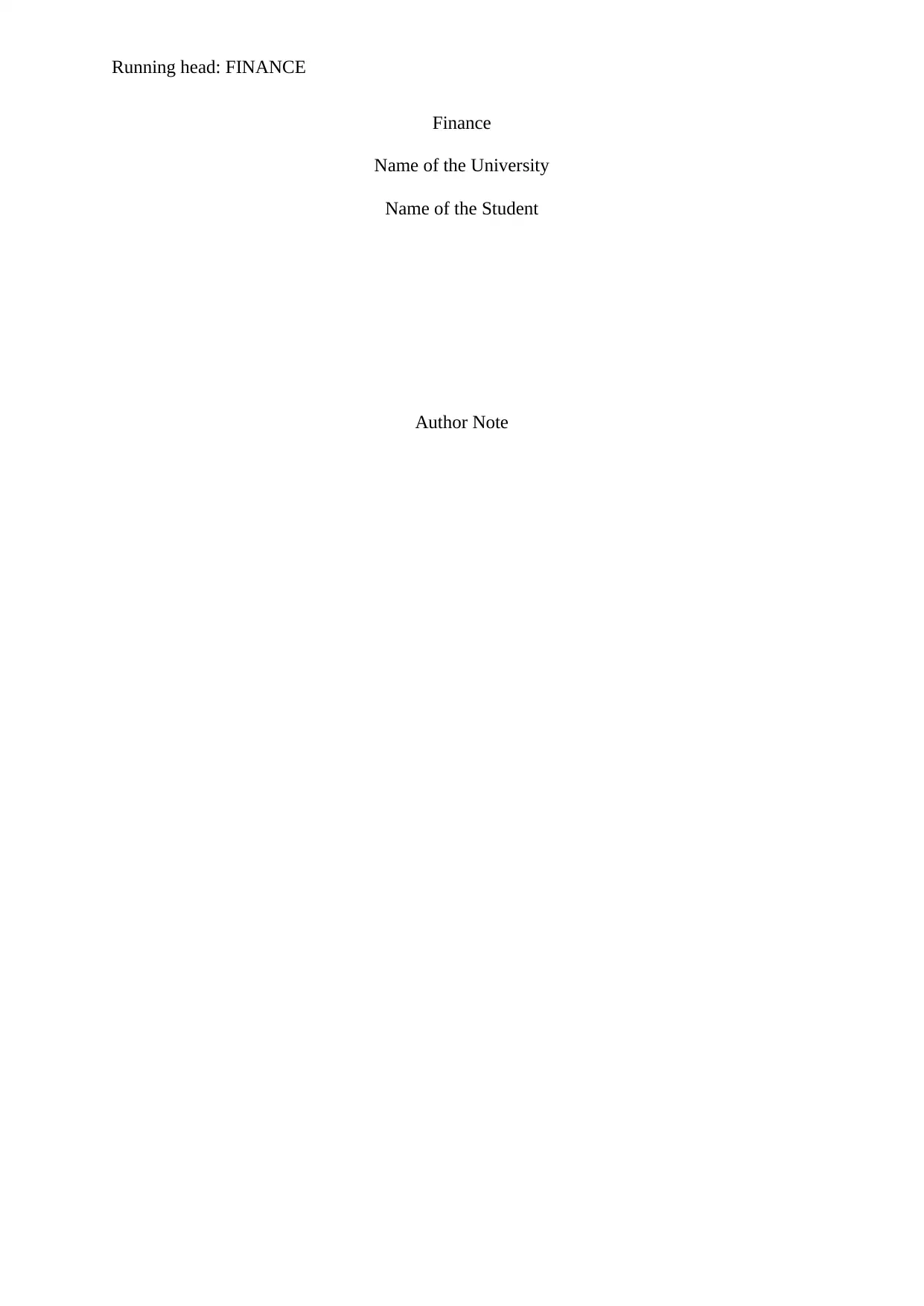
Running head: FINANCE
Finance
Name of the University
Name of the Student
Author Note
Finance
Name of the University
Name of the Student
Author Note
Paraphrase This Document
Need a fresh take? Get an instant paraphrase of this document with our AI Paraphraser
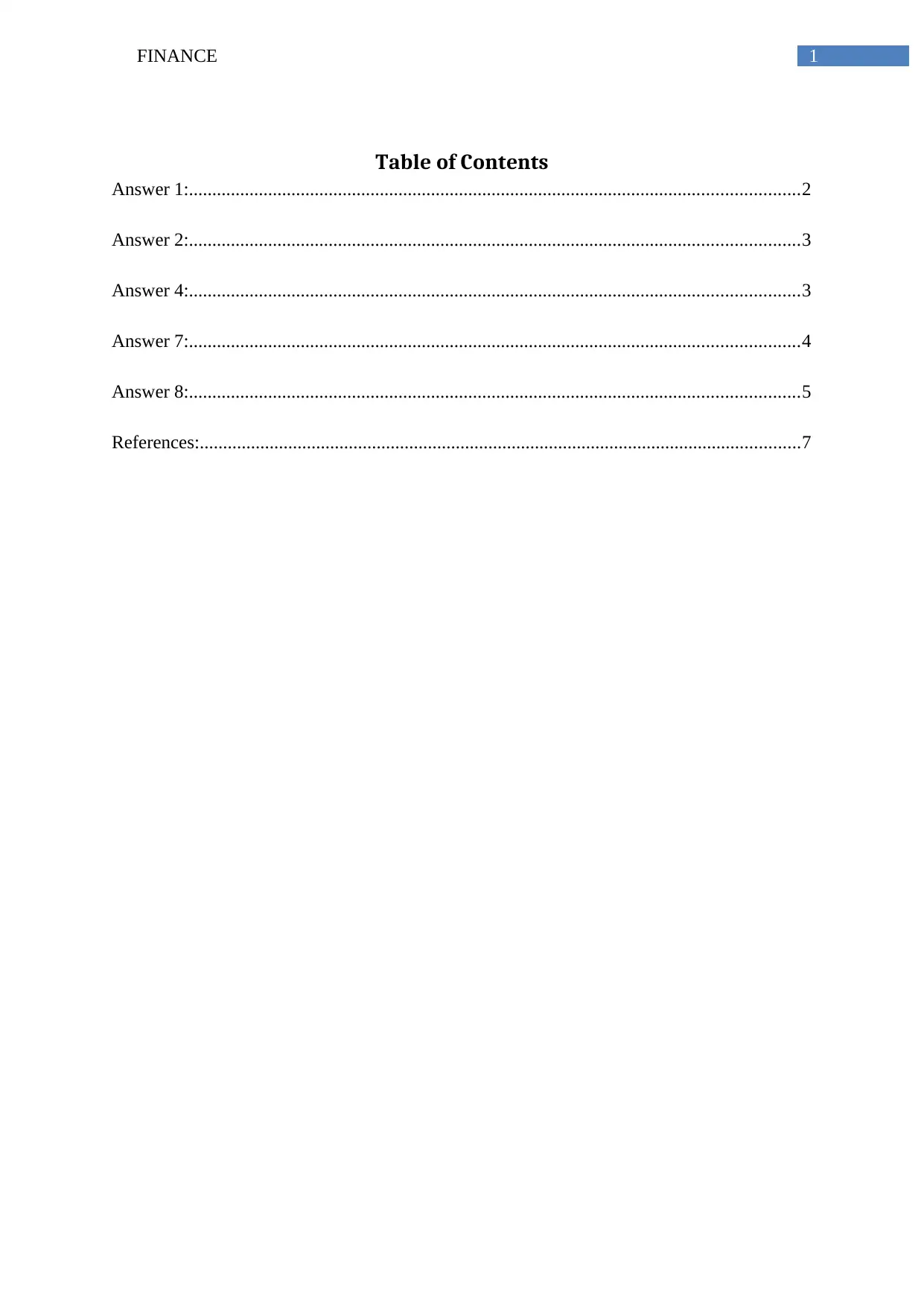
1FINANCE
Table of Contents
Answer 1:...................................................................................................................................2
Answer 2:...................................................................................................................................3
Answer 4:...................................................................................................................................3
Answer 7:...................................................................................................................................4
Answer 8:...................................................................................................................................5
References:.................................................................................................................................7
Table of Contents
Answer 1:...................................................................................................................................2
Answer 2:...................................................................................................................................3
Answer 4:...................................................................................................................................3
Answer 7:...................................................................................................................................4
Answer 8:...................................................................................................................................5
References:.................................................................................................................................7
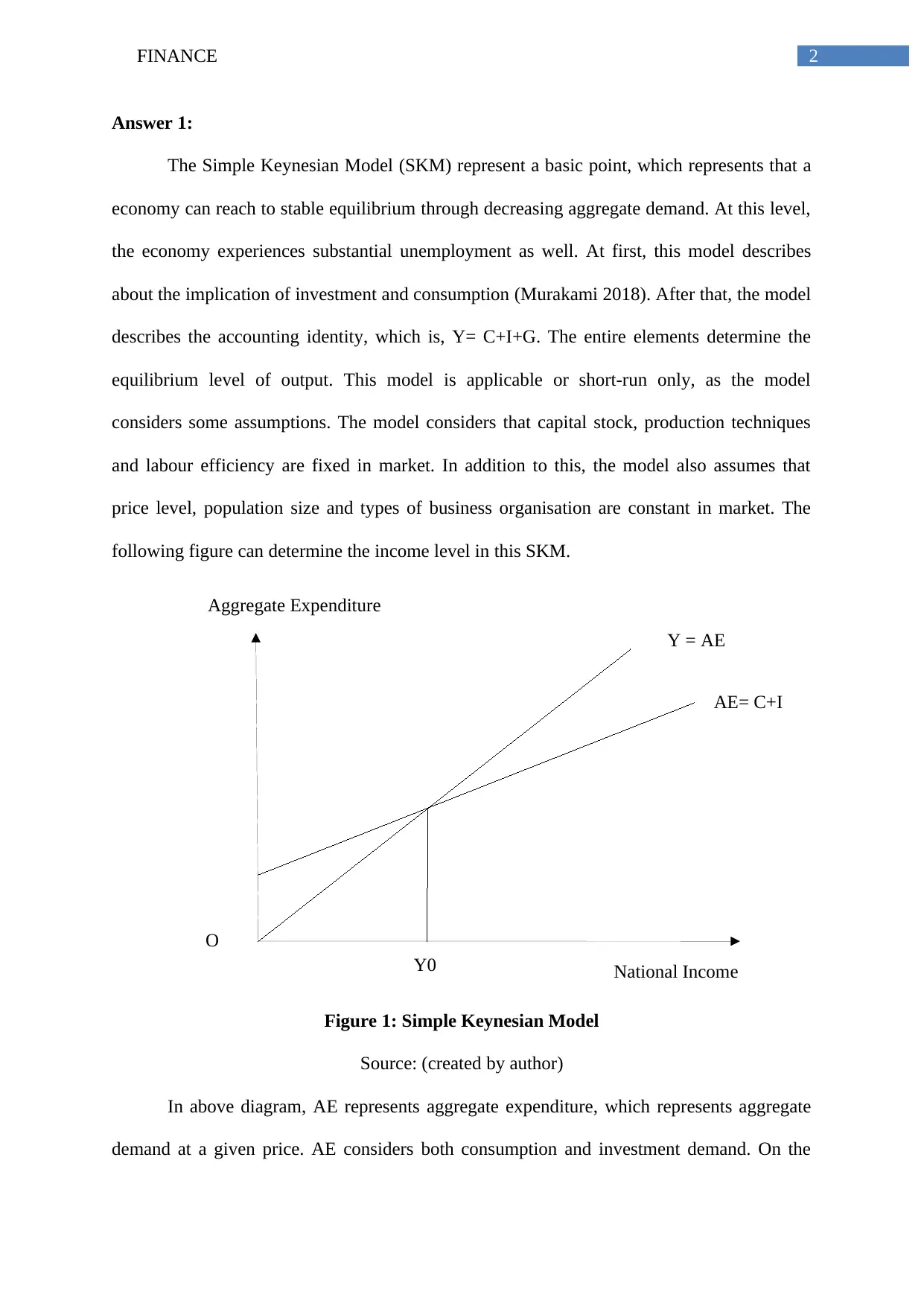
2FINANCE
Aggregate Expenditure
National Income
O
Y0
AE= C+I
Y = AE
Answer 1:
The Simple Keynesian Model (SKM) represent a basic point, which represents that a
economy can reach to stable equilibrium through decreasing aggregate demand. At this level,
the economy experiences substantial unemployment as well. At first, this model describes
about the implication of investment and consumption (Murakami 2018). After that, the model
describes the accounting identity, which is, Y= C+I+G. The entire elements determine the
equilibrium level of output. This model is applicable or short-run only, as the model
considers some assumptions. The model considers that capital stock, production techniques
and labour efficiency are fixed in market. In addition to this, the model also assumes that
price level, population size and types of business organisation are constant in market. The
following figure can determine the income level in this SKM.
Figure 1: Simple Keynesian Model
Source: (created by author)
In above diagram, AE represents aggregate expenditure, which represents aggregate
demand at a given price. AE considers both consumption and investment demand. On the
Aggregate Expenditure
National Income
O
Y0
AE= C+I
Y = AE
Answer 1:
The Simple Keynesian Model (SKM) represent a basic point, which represents that a
economy can reach to stable equilibrium through decreasing aggregate demand. At this level,
the economy experiences substantial unemployment as well. At first, this model describes
about the implication of investment and consumption (Murakami 2018). After that, the model
describes the accounting identity, which is, Y= C+I+G. The entire elements determine the
equilibrium level of output. This model is applicable or short-run only, as the model
considers some assumptions. The model considers that capital stock, production techniques
and labour efficiency are fixed in market. In addition to this, the model also assumes that
price level, population size and types of business organisation are constant in market. The
following figure can determine the income level in this SKM.
Figure 1: Simple Keynesian Model
Source: (created by author)
In above diagram, AE represents aggregate expenditure, which represents aggregate
demand at a given price. AE considers both consumption and investment demand. On the
⊘ This is a preview!⊘
Do you want full access?
Subscribe today to unlock all pages.

Trusted by 1+ million students worldwide
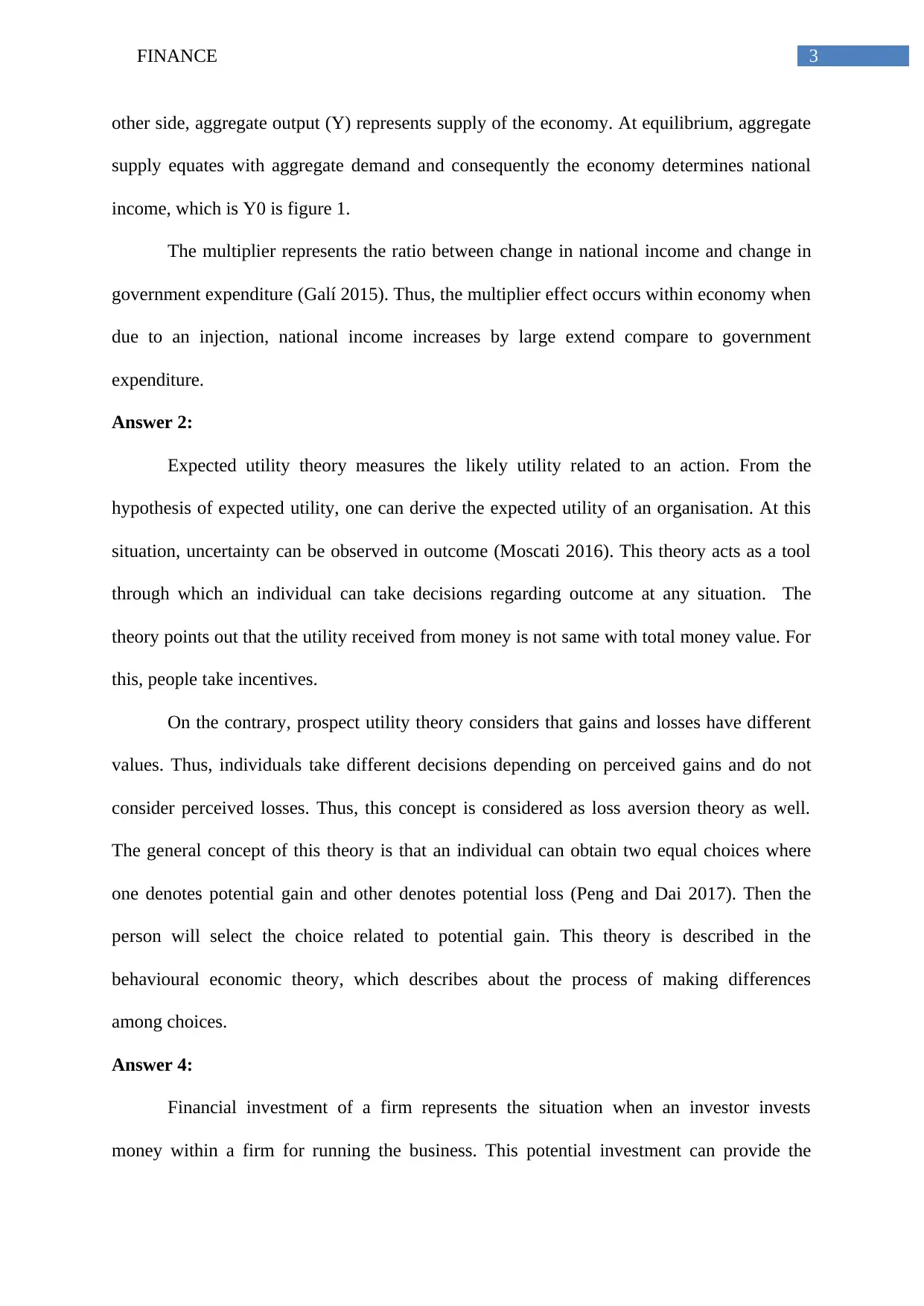
3FINANCE
other side, aggregate output (Y) represents supply of the economy. At equilibrium, aggregate
supply equates with aggregate demand and consequently the economy determines national
income, which is Y0 is figure 1.
The multiplier represents the ratio between change in national income and change in
government expenditure (Galí 2015). Thus, the multiplier effect occurs within economy when
due to an injection, national income increases by large extend compare to government
expenditure.
Answer 2:
Expected utility theory measures the likely utility related to an action. From the
hypothesis of expected utility, one can derive the expected utility of an organisation. At this
situation, uncertainty can be observed in outcome (Moscati 2016). This theory acts as a tool
through which an individual can take decisions regarding outcome at any situation. The
theory points out that the utility received from money is not same with total money value. For
this, people take incentives.
On the contrary, prospect utility theory considers that gains and losses have different
values. Thus, individuals take different decisions depending on perceived gains and do not
consider perceived losses. Thus, this concept is considered as loss aversion theory as well.
The general concept of this theory is that an individual can obtain two equal choices where
one denotes potential gain and other denotes potential loss (Peng and Dai 2017). Then the
person will select the choice related to potential gain. This theory is described in the
behavioural economic theory, which describes about the process of making differences
among choices.
Answer 4:
Financial investment of a firm represents the situation when an investor invests
money within a firm for running the business. This potential investment can provide the
other side, aggregate output (Y) represents supply of the economy. At equilibrium, aggregate
supply equates with aggregate demand and consequently the economy determines national
income, which is Y0 is figure 1.
The multiplier represents the ratio between change in national income and change in
government expenditure (Galí 2015). Thus, the multiplier effect occurs within economy when
due to an injection, national income increases by large extend compare to government
expenditure.
Answer 2:
Expected utility theory measures the likely utility related to an action. From the
hypothesis of expected utility, one can derive the expected utility of an organisation. At this
situation, uncertainty can be observed in outcome (Moscati 2016). This theory acts as a tool
through which an individual can take decisions regarding outcome at any situation. The
theory points out that the utility received from money is not same with total money value. For
this, people take incentives.
On the contrary, prospect utility theory considers that gains and losses have different
values. Thus, individuals take different decisions depending on perceived gains and do not
consider perceived losses. Thus, this concept is considered as loss aversion theory as well.
The general concept of this theory is that an individual can obtain two equal choices where
one denotes potential gain and other denotes potential loss (Peng and Dai 2017). Then the
person will select the choice related to potential gain. This theory is described in the
behavioural economic theory, which describes about the process of making differences
among choices.
Answer 4:
Financial investment of a firm represents the situation when an investor invests
money within a firm for running the business. This potential investment can provide the
Paraphrase This Document
Need a fresh take? Get an instant paraphrase of this document with our AI Paraphraser
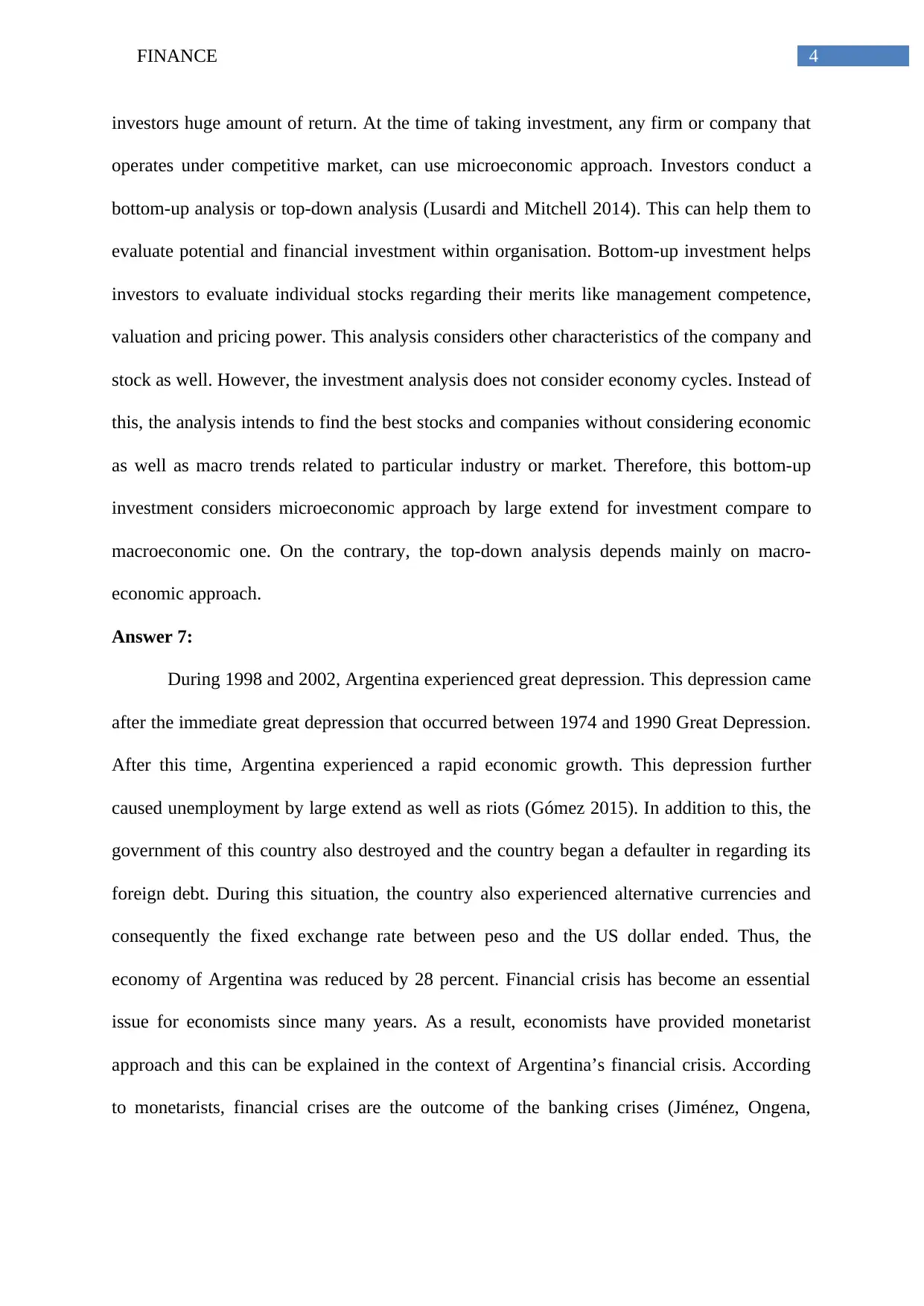
4FINANCE
investors huge amount of return. At the time of taking investment, any firm or company that
operates under competitive market, can use microeconomic approach. Investors conduct a
bottom-up analysis or top-down analysis (Lusardi and Mitchell 2014). This can help them to
evaluate potential and financial investment within organisation. Bottom-up investment helps
investors to evaluate individual stocks regarding their merits like management competence,
valuation and pricing power. This analysis considers other characteristics of the company and
stock as well. However, the investment analysis does not consider economy cycles. Instead of
this, the analysis intends to find the best stocks and companies without considering economic
as well as macro trends related to particular industry or market. Therefore, this bottom-up
investment considers microeconomic approach by large extend for investment compare to
macroeconomic one. On the contrary, the top-down analysis depends mainly on macro-
economic approach.
Answer 7:
During 1998 and 2002, Argentina experienced great depression. This depression came
after the immediate great depression that occurred between 1974 and 1990 Great Depression.
After this time, Argentina experienced a rapid economic growth. This depression further
caused unemployment by large extend as well as riots (Gómez 2015). In addition to this, the
government of this country also destroyed and the country began a defaulter in regarding its
foreign debt. During this situation, the country also experienced alternative currencies and
consequently the fixed exchange rate between peso and the US dollar ended. Thus, the
economy of Argentina was reduced by 28 percent. Financial crisis has become an essential
issue for economists since many years. As a result, economists have provided monetarist
approach and this can be explained in the context of Argentina’s financial crisis. According
to monetarists, financial crises are the outcome of the banking crises (Jiménez, Ongena,
investors huge amount of return. At the time of taking investment, any firm or company that
operates under competitive market, can use microeconomic approach. Investors conduct a
bottom-up analysis or top-down analysis (Lusardi and Mitchell 2014). This can help them to
evaluate potential and financial investment within organisation. Bottom-up investment helps
investors to evaluate individual stocks regarding their merits like management competence,
valuation and pricing power. This analysis considers other characteristics of the company and
stock as well. However, the investment analysis does not consider economy cycles. Instead of
this, the analysis intends to find the best stocks and companies without considering economic
as well as macro trends related to particular industry or market. Therefore, this bottom-up
investment considers microeconomic approach by large extend for investment compare to
macroeconomic one. On the contrary, the top-down analysis depends mainly on macro-
economic approach.
Answer 7:
During 1998 and 2002, Argentina experienced great depression. This depression came
after the immediate great depression that occurred between 1974 and 1990 Great Depression.
After this time, Argentina experienced a rapid economic growth. This depression further
caused unemployment by large extend as well as riots (Gómez 2015). In addition to this, the
government of this country also destroyed and the country began a defaulter in regarding its
foreign debt. During this situation, the country also experienced alternative currencies and
consequently the fixed exchange rate between peso and the US dollar ended. Thus, the
economy of Argentina was reduced by 28 percent. Financial crisis has become an essential
issue for economists since many years. As a result, economists have provided monetarist
approach and this can be explained in the context of Argentina’s financial crisis. According
to monetarists, financial crises are the outcome of the banking crises (Jiménez, Ongena,
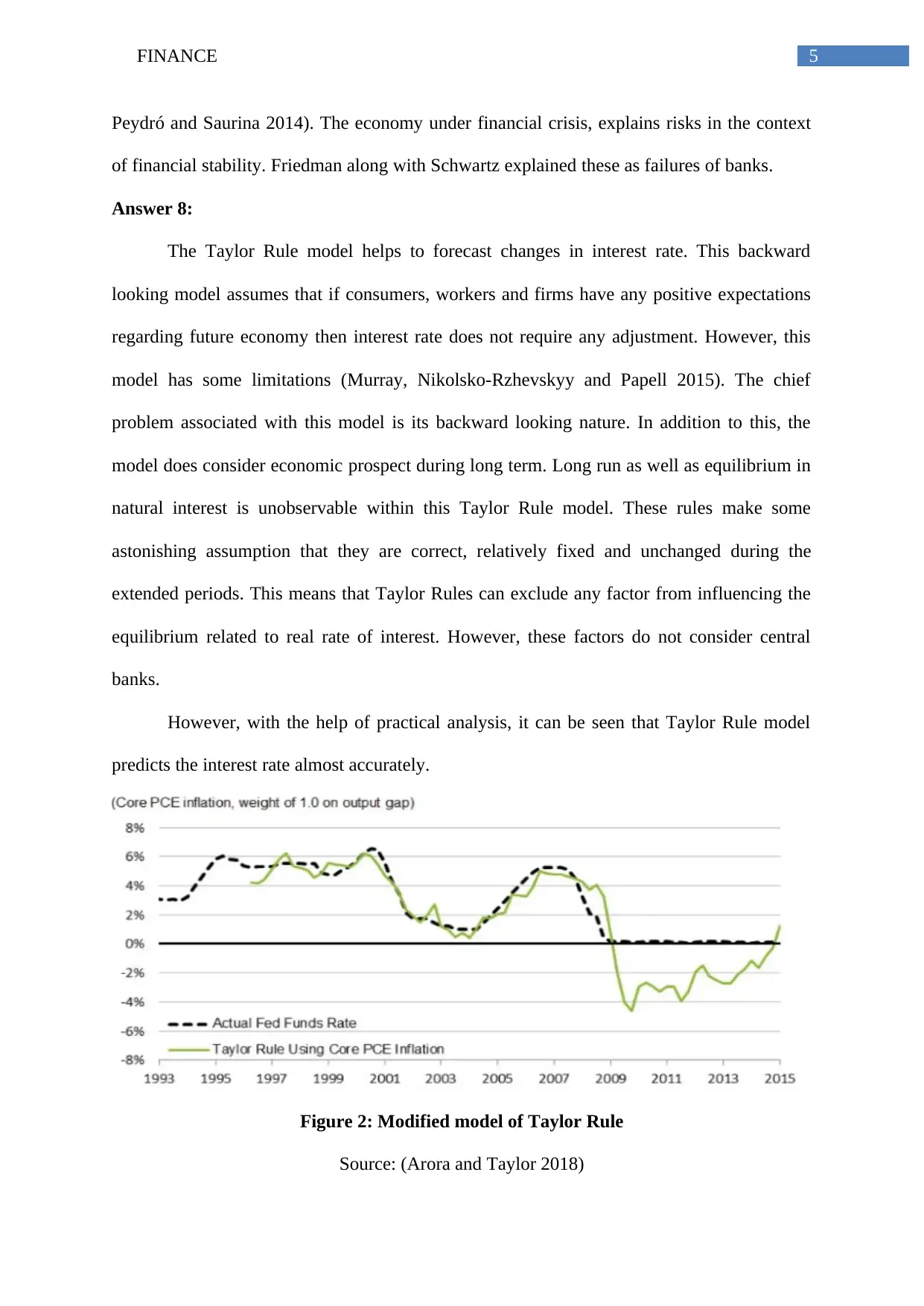
5FINANCE
Peydró and Saurina 2014). The economy under financial crisis, explains risks in the context
of financial stability. Friedman along with Schwartz explained these as failures of banks.
Answer 8:
The Taylor Rule model helps to forecast changes in interest rate. This backward
looking model assumes that if consumers, workers and firms have any positive expectations
regarding future economy then interest rate does not require any adjustment. However, this
model has some limitations (Murray, Nikolsko-Rzhevskyy and Papell 2015). The chief
problem associated with this model is its backward looking nature. In addition to this, the
model does consider economic prospect during long term. Long run as well as equilibrium in
natural interest is unobservable within this Taylor Rule model. These rules make some
astonishing assumption that they are correct, relatively fixed and unchanged during the
extended periods. This means that Taylor Rules can exclude any factor from influencing the
equilibrium related to real rate of interest. However, these factors do not consider central
banks.
However, with the help of practical analysis, it can be seen that Taylor Rule model
predicts the interest rate almost accurately.
Figure 2: Modified model of Taylor Rule
Source: (Arora and Taylor 2018)
Peydró and Saurina 2014). The economy under financial crisis, explains risks in the context
of financial stability. Friedman along with Schwartz explained these as failures of banks.
Answer 8:
The Taylor Rule model helps to forecast changes in interest rate. This backward
looking model assumes that if consumers, workers and firms have any positive expectations
regarding future economy then interest rate does not require any adjustment. However, this
model has some limitations (Murray, Nikolsko-Rzhevskyy and Papell 2015). The chief
problem associated with this model is its backward looking nature. In addition to this, the
model does consider economic prospect during long term. Long run as well as equilibrium in
natural interest is unobservable within this Taylor Rule model. These rules make some
astonishing assumption that they are correct, relatively fixed and unchanged during the
extended periods. This means that Taylor Rules can exclude any factor from influencing the
equilibrium related to real rate of interest. However, these factors do not consider central
banks.
However, with the help of practical analysis, it can be seen that Taylor Rule model
predicts the interest rate almost accurately.
Figure 2: Modified model of Taylor Rule
Source: (Arora and Taylor 2018)
⊘ This is a preview!⊘
Do you want full access?
Subscribe today to unlock all pages.

Trusted by 1+ million students worldwide
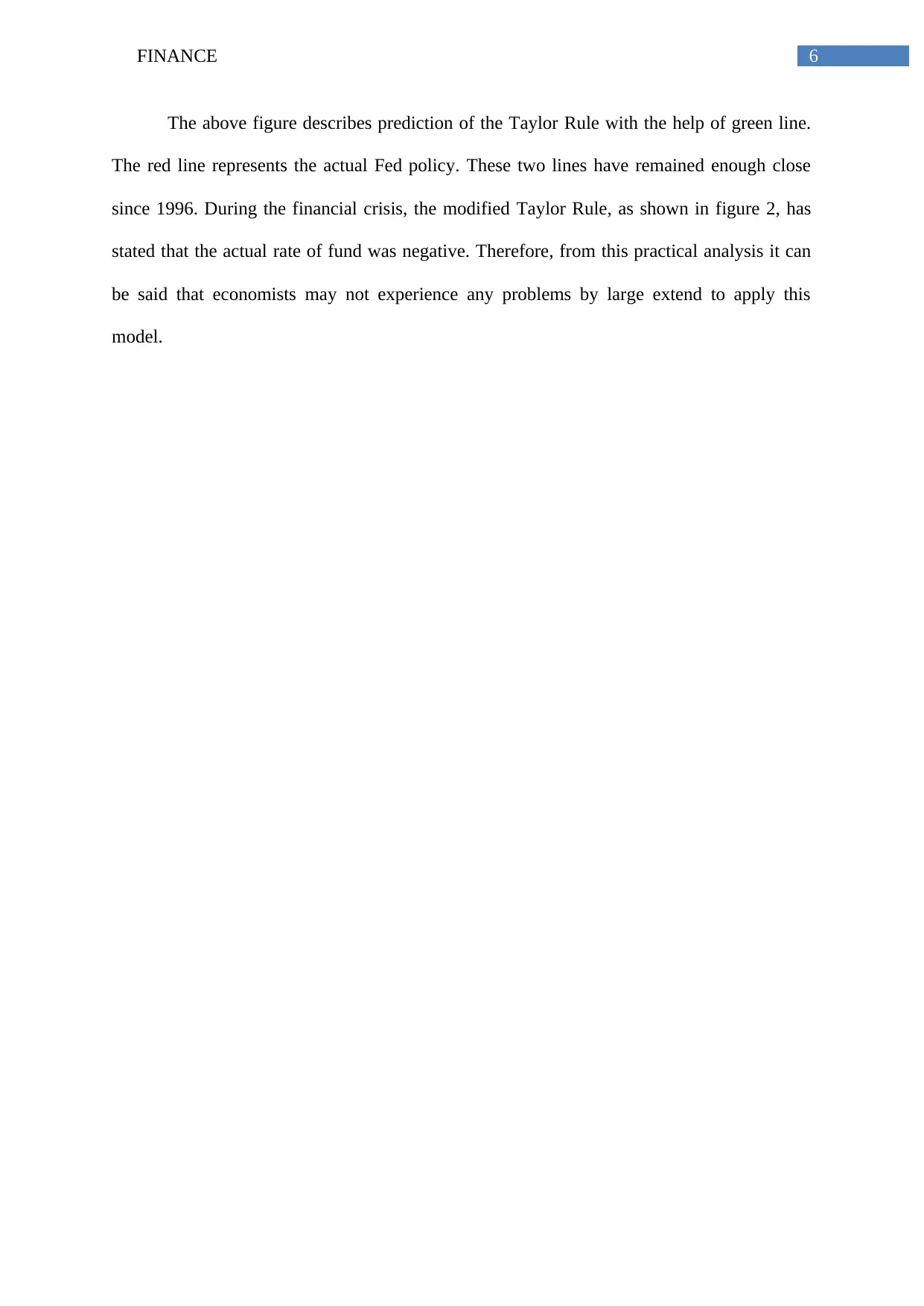
6FINANCE
The above figure describes prediction of the Taylor Rule with the help of green line.
The red line represents the actual Fed policy. These two lines have remained enough close
since 1996. During the financial crisis, the modified Taylor Rule, as shown in figure 2, has
stated that the actual rate of fund was negative. Therefore, from this practical analysis it can
be said that economists may not experience any problems by large extend to apply this
model.
The above figure describes prediction of the Taylor Rule with the help of green line.
The red line represents the actual Fed policy. These two lines have remained enough close
since 1996. During the financial crisis, the modified Taylor Rule, as shown in figure 2, has
stated that the actual rate of fund was negative. Therefore, from this practical analysis it can
be said that economists may not experience any problems by large extend to apply this
model.
Paraphrase This Document
Need a fresh take? Get an instant paraphrase of this document with our AI Paraphraser
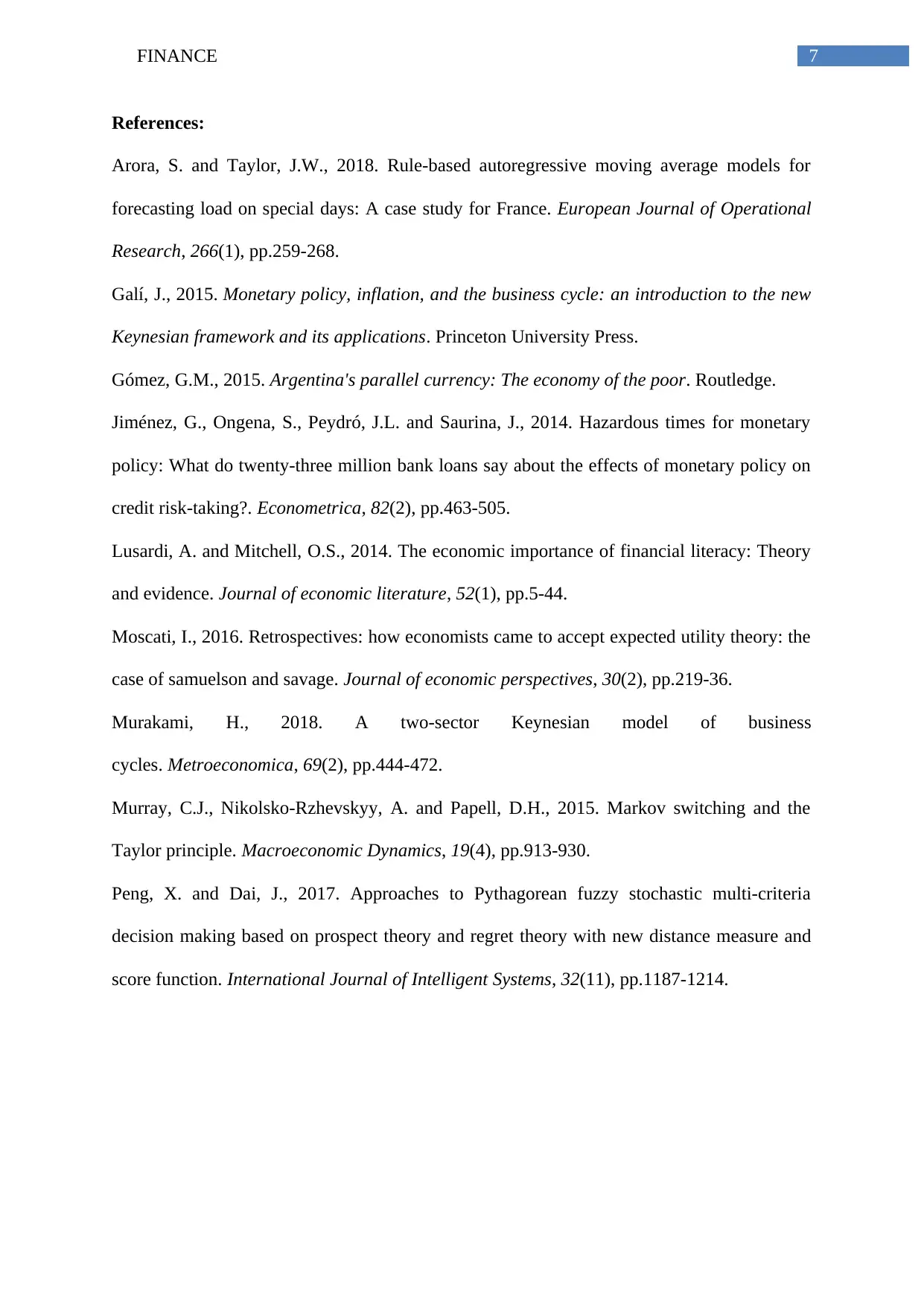
7FINANCE
References:
Arora, S. and Taylor, J.W., 2018. Rule-based autoregressive moving average models for
forecasting load on special days: A case study for France. European Journal of Operational
Research, 266(1), pp.259-268.
Galí, J., 2015. Monetary policy, inflation, and the business cycle: an introduction to the new
Keynesian framework and its applications. Princeton University Press.
Gómez, G.M., 2015. Argentina's parallel currency: The economy of the poor. Routledge.
Jiménez, G., Ongena, S., Peydró, J.L. and Saurina, J., 2014. Hazardous times for monetary
policy: What do twenty‐three million bank loans say about the effects of monetary policy on
credit risk‐taking?. Econometrica, 82(2), pp.463-505.
Lusardi, A. and Mitchell, O.S., 2014. The economic importance of financial literacy: Theory
and evidence. Journal of economic literature, 52(1), pp.5-44.
Moscati, I., 2016. Retrospectives: how economists came to accept expected utility theory: the
case of samuelson and savage. Journal of economic perspectives, 30(2), pp.219-36.
Murakami, H., 2018. A two‐sector Keynesian model of business
cycles. Metroeconomica, 69(2), pp.444-472.
Murray, C.J., Nikolsko-Rzhevskyy, A. and Papell, D.H., 2015. Markov switching and the
Taylor principle. Macroeconomic Dynamics, 19(4), pp.913-930.
Peng, X. and Dai, J., 2017. Approaches to Pythagorean fuzzy stochastic multi‐criteria
decision making based on prospect theory and regret theory with new distance measure and
score function. International Journal of Intelligent Systems, 32(11), pp.1187-1214.
References:
Arora, S. and Taylor, J.W., 2018. Rule-based autoregressive moving average models for
forecasting load on special days: A case study for France. European Journal of Operational
Research, 266(1), pp.259-268.
Galí, J., 2015. Monetary policy, inflation, and the business cycle: an introduction to the new
Keynesian framework and its applications. Princeton University Press.
Gómez, G.M., 2015. Argentina's parallel currency: The economy of the poor. Routledge.
Jiménez, G., Ongena, S., Peydró, J.L. and Saurina, J., 2014. Hazardous times for monetary
policy: What do twenty‐three million bank loans say about the effects of monetary policy on
credit risk‐taking?. Econometrica, 82(2), pp.463-505.
Lusardi, A. and Mitchell, O.S., 2014. The economic importance of financial literacy: Theory
and evidence. Journal of economic literature, 52(1), pp.5-44.
Moscati, I., 2016. Retrospectives: how economists came to accept expected utility theory: the
case of samuelson and savage. Journal of economic perspectives, 30(2), pp.219-36.
Murakami, H., 2018. A two‐sector Keynesian model of business
cycles. Metroeconomica, 69(2), pp.444-472.
Murray, C.J., Nikolsko-Rzhevskyy, A. and Papell, D.H., 2015. Markov switching and the
Taylor principle. Macroeconomic Dynamics, 19(4), pp.913-930.
Peng, X. and Dai, J., 2017. Approaches to Pythagorean fuzzy stochastic multi‐criteria
decision making based on prospect theory and regret theory with new distance measure and
score function. International Journal of Intelligent Systems, 32(11), pp.1187-1214.
1 out of 8
Related Documents
Your All-in-One AI-Powered Toolkit for Academic Success.
+13062052269
info@desklib.com
Available 24*7 on WhatsApp / Email
![[object Object]](/_next/static/media/star-bottom.7253800d.svg)
Unlock your academic potential
Copyright © 2020–2025 A2Z Services. All Rights Reserved. Developed and managed by ZUCOL.





